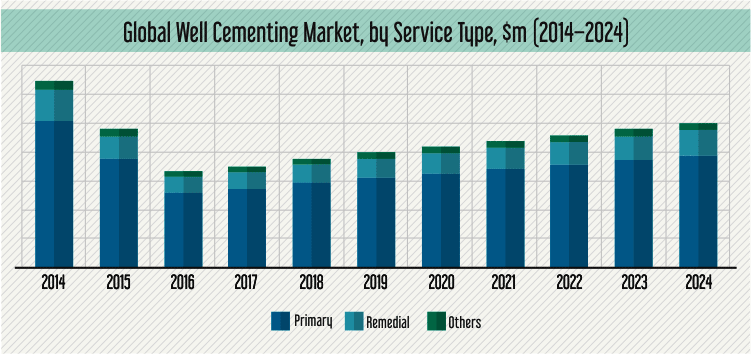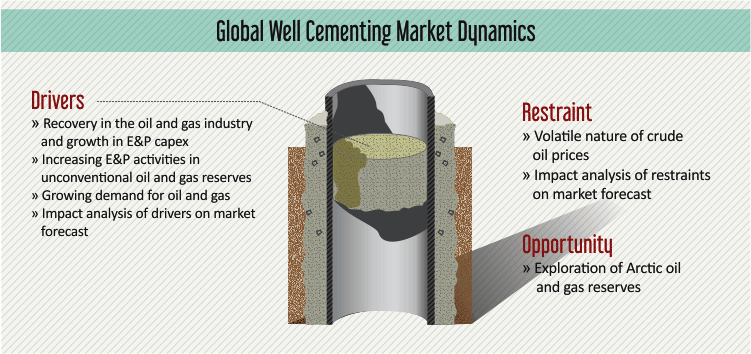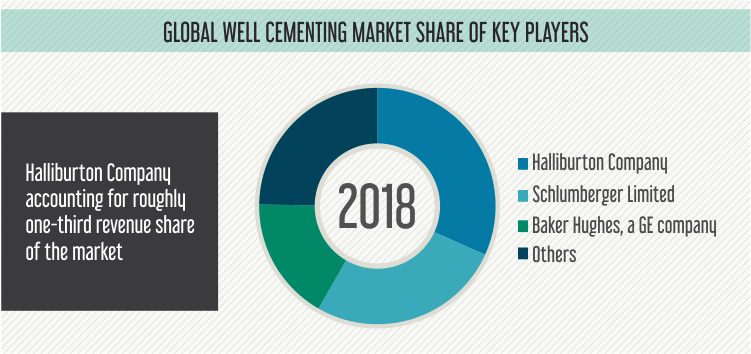Report Code: 10887 | Available Format: PDF | Pages: 124
Well Cementing Market by Service Type (Primary, Remedial), by Well Type (Oil, Gas, Shale Gas), by Application (Onshore, Offshore), by Geography (U.S., Canada, Norway, U.K., Russia, China, India, Indonesia, Malaysia, Mexico, Brazil, Venezuela, Colombia, Saudi Arabia, U.A.E., Kuwait, Nigeria, Algeria, Angola) - Global Market Size, Share, Development, Growth, and Demand Forecast, 2014-2024
- Report Code: 10887
- Available Format: PDF
- Pages: 124
- Report Description
- Table of Contents
- Market Segmentation
- Request Free Sample
Well Cementing Market Overview
Estimated at $7,577.6 million in 2018, the global well cementing market is expected to reach $10,065.4 million by 2024, demonstrating a CAGR of 4.7% during the forecast period. The market growth is mainly driven by the increase in exploration and production (E&P) activities in both conventional and unconventional oil and gas reserves of the world to meet the growing demand for energy products, such as gasoline, gas oil, heating oil, fuel oil, aviation turbine fuel, liquified petroleum gas, piped natural gas, and compressed natural gas.

Well cementing is a service that helps prevent the fluid movement from the reservoir to the wellbore. It also protects and supports the well casing in addition to providing zonal isolation. Oilfield service companies offer these services for the completion of new wells and for the sealing of lost circulation zones or areas where there is less/absence of flow within the well.
Based on service type, the well cementing market is classified into primary, remedial, and other services, including advanced cementing. Of these, primary well cementing accounted for an estimated revenue of 75.0% in the market in 2018. This can be mainly attributed to the increase in E&P activities coupled with the need for zonal isolation during well cementing, which led to the demand for primary services. The market for this category is further expected to increase on account of the revival in crude oil prices since 2017.
On the basis of well type, the well cementing market is categorized into oil, gas, and shale gas. Under this segment, oil well cementing held the largest share in the market, with an estimated contribution of 55.0% in 2018. In recent years, the recovery in crude oil prices has encouraged E&P companies to invest more in crude oil E&P projects, which, in turn, has led to the drilling of new wells. This increase in investments in new projects is further expected to fuel the market growth in this category during the forecast period.
The well cementing market is also bifurcated into onshore and offshore applications. Between the two, cementing services for onshore wells held the larger share in the market in 2018. This can be mainly attributed to the presence of a large number of onshore reserves globally, which can be drilled at a low operational cost. In addition, the development of advanced exploration technologies is further facilitating deep drilling operations of existing onshore wells, thereby boosting the market for onshore well cementing.
Well Cementing Market Dynamics

Drivers
The growth of the well cementing market is mainly driven by the recovery in oil and gas industry, increasing E&P activities in unconventional reserves, and growing demand for oil and gas end-use products.
Well cementing is a major application area in the well completion process. Globally, the number of well completions is increasing on account of the growing E&P activities in both conventional and unconventional oil and gas reserves. This has primarily been supported by the short-term recovery of crude oil prices in 2018, with the oil and gas industry expected to continue on the recovery path in the forthcoming period as well. Countries such as the U.S., Russia, China, and Brazil are among the major revenue generators in the well cementing industry, as E&P investments in these countries have picked up in recent years. Owing to this, the demand for cementing for well operations in the global oil and gas industry is growing, thereby supporting the growth of the well cementing market.
Restraint
Crude oil and gas prices have a major impact on the global E&P spending, which, in result, affects the value chain of upstream oil and gas projects in the long run. For instance, the crude oil prices had fallen in mid-2014 due to global political and economic factors. Due to this, several ongoing projects of upstream companies had suffered. Thus, volatility in crude oil prices impacts the well cementing market growth, as any decline in crude oil prices may result in a delay in several upstream activities, such as drilling, exploration, and production.
Opportunity
The potential for high volume production in untapped Arctic oil and gas reserves can be viewed as a growth opportunity by the players in the well cementing market. The Arctic region is home to a large number of both onshore and offshore oil and gas reserves. According to the United States Geological Survey (USGS), the Arctic region is estimated to contain around 90.0 billion barrels of undiscovered oil, 1,669.0 trillion cubic feet of gas, and 44.0 billion barrels of undiscovered natural gas liquids. Thus, the immense potential in reserves is drawing the attention of several E&P companies towards the Arctic region, with Russia, the U.S., Canada, and Norway having already started E&P activities in the region.
Well Cementing Market Competitive Landscape

Some of the major players operating in the global well cementing market are Consolidated Oil Well Services LLC, Nine Energy Service Inc., Gulf Energy SAOC, Magnum Cementing Services Ltd., Calfrac Well Services Ltd., China Oilfield Services Limited, Baker Hughes, a GE company, Schlumberger N.V., Halliburton Company, and Weatherford International plc.
Want a report tailored exactly to your business strategy?
Request CustomizationWant an insight-rich discussion with the report author?
Speak to AnalystOur dedication to providing the most-accurate market information has earned us verification by Dun & Bradstreet (D&B). We strive for quality checking of the highest level to enable data-driven decision making for you
Our insights into the minutest levels of the markets, including the latest trends and competitive landscape, give you all the answers you need to take your business to new heights
With 24/7 research support, we ensure that the wheels of your business never stop turning. Don’t let time stand in your way. Get all your queries answered with a simple phone call or email, as and when required
We take a cautious approach to protecting your personal and confidential information. Trust is the strongest bond that connects us and our clients, and trust we build by complying with all international and domestic data protection and privacy laws